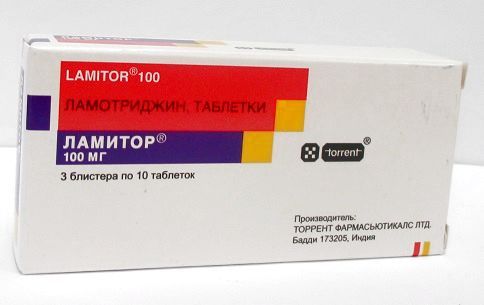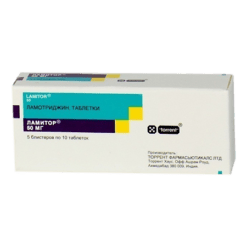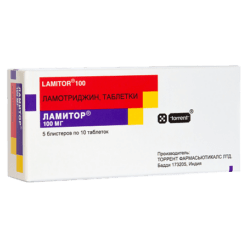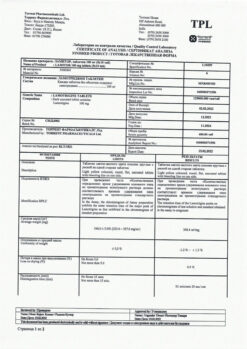No products in the cart.
Lamitor, tablets 100 mg 30 pcs
€26.12 €21.77
Description
Lamotrigine
Indications
Indications
Lamitor is recommended as monotherapy and adjuvant therapy for adults and children over 12 years of age:
simple partial seizures;
complex partial seizures;
secondary generalized tonic-clonic seizures;
primary generalized tonic-clonic seizures;
absence seizures are typical;
absence seizures are atypical;
myoclonic seizures;
seizures resistant to other antiepileptic drugs of any type.
Lamitor is also used as an adjuvant therapy for children aged 2 to 12 years.
Pharmacological effect
Pharmacological effect
Pharmacotherapeutic group: Anticonvulsant
Pharmacological action
Anticonvulsant (antiepileptic) drug. Voltage-gated sodium channel blocker. Causes a block of impulse discharges in cultured neurons and inhibits excessive release of glutamate (amino acids that play a key role in the generation of epileptic seizures) along with inhibition of glutamate-induced effector impulses.
Pharmacokinetics
Suction
After oral administration, lamotrigine is quickly and completely absorbed from the gastrointestinal tract. Cmax in blood plasma is observed 2.5±1.5 hours after oral administration. The time to reach Cmax is slightly longer if the drug is taken after meals, but the degree of absorption remains unchanged. Pharmacokinetics are linear up to a dose of 450 mg, the maximum single dose that has been studied. There is significant individual variation in drug Cmax values, but individual concentrations vary very little.
Distribution
Plasma protein binding is approximately 55%.
Metabolism
Metabolized in the liver with the formation of predominantly glucuronides.
Removal
T1/2 in healthy adults is 24-35 hours.
Average clearance values in healthy people are 39±14 ml/min.
Lamotrigine is excreted from the body in the urine in the form of glucuronides. Less than 10% is excreted unchanged in the urine. Only 2% of metabolic products are excreted in feces.
Pharmacokinetics in special clinical situations
T1/2 of lamotrigine is largely dependent on concomitant drug therapy.
T1/2 of lamotrigine is reduced to 14 hours when combined with drugs that induce the activity of cytochrome P450 isoenzymes, such as carbamazepine and phenytoin, and increases to an average of approximately 70 hours when combined with sodium valproate.
T1/2 of lamotrigine in children is usually shorter than in adults. T1/2 in children is approximately 7 hours when taken with drugs that induce isoenzyme activity, such as carbamazepine, phenytoin, phenobarbital and primidone. T1/2 increases to 45-55 hours when combined with sodium valproate.
Studies of the pharmacokinetics of lamotrigine in single doses in patients with kidney disease indicate that the pharmacokinetic parameters change slightly, but the concentrations of the main metabolite in the form of glucuronide increase almost 8-fold due to a decrease in renal clearance.
Special instructions
Special instructions
Information on the use of Lamitor in elderly patients is limited. Therefore, caution should be exercised in prescribing the drug to this category of patients.
If the dose of Lamitor is exceeded, skin rash may develop (in this situation, the drug should be discontinued).
In some cases, when prescribing the drug, severe skin rash (including Stevens-Johnson syndrome) may develop. Such reactions often develop in children. Lamitor should be discontinued at the first sign of a rash. The risk of developing such complications increases when Lamitor is prescribed concomitantly with sodium valproate and if the dose of Lamitor used exceeds the recommended initial and maximum daily dose.
If a skin rash develops, use of the drug should be stopped immediately.
When using Lamitor, it is possible to develop such hypersensitivity symptoms (in some cases, even death) such as fever, malaise, cold symptoms, drowsiness, lymphadenopathy, facial swelling and, in very rare cases, liver dysfunction, hematopoietic disorders (leukopenia and thrombocytopenia). In most patients, these symptoms disappear after stopping Lamitor.
If rash, chills, cold symptoms, drowsiness, or worsening seizure control (especially during the first month) occur while using the drug, liver function tests, kidney function tests, and blood clotting should be monitored.
If Lamitor is abruptly discontinued, seizures may become more frequent. The dose of Lamitor should be reduced gradually over 2 weeks.
In patients with impaired renal function in the terminal stage of the disease, accumulation of the metabolite in the form of a glucuronide should be expected. Therefore, if it is necessary to prescribe to such patients, caution should be exercised.
Impact on the ability to drive vehicles and machinery
The question of the ability to drive vehicles and work with moving mechanisms while taking Lamitor is decided individually, taking into account the clinical situation.
Active ingredient
Active ingredient
Lamotrigine
Composition
Composition
Active substance: lamotrigine
Excipients: lactose monohydrate, microcrystalline cellulose, iron oxide yellow dye, povidone K-30, sodium carboxymethyl starch (type A), magnesium stearate, talc, colloidal silicon dioxide.
Pregnancy
Pregnancy
The drug should not be prescribed during pregnancy and lactation, except in cases where the expected benefit of therapy for the mother outweighs the potential risk for the fetus and child.
Contraindications
Contraindications
severe liver dysfunction;
hypersensitivity to lamotrigine and other components of the drug.
Side Effects
Side Effects
Side effects observed when Lamitor is prescribed as monotherapy
From the central nervous system: dizziness, headache, drowsiness, sleep disturbance, increased fatigue.
From the digestive system: nausea.
Allergic reactions: maculopapular skin rash (2%), most often observed in the first 4 weeks after the start of treatment and disappears after discontinuation of the drug. In some cases – Stevens-Johnson syndrome, angioedema, toxic epidermal necrolysis.
Side effects observed when Lamitor is prescribed as an additional therapy to standard antiepileptic drugs
From the side of the central nervous system: dizziness, headache, drowsiness, imbalance, increased fatigue, irritability, aggressiveness, tremor, confusion.
From the side of the organ of vision: diplopia, impaired visual acuity.
From the hematopoietic system: neutropenia, leukopenia.
From the digestive system: nausea, vomiting, dyspeptic symptoms.
Interaction
Interaction
When used simultaneously with antiepileptic drugs that induce liver isoenzymes (phenytoin, carbamazepine, phenobarbital, primidone), the metabolism of Lamitor increases, which may require an increase in its dose.
Sodium valproate, which competes with lamotrigine for liver metabolizing isoenzymes, inhibits its metabolism. There is no evidence that Lamitor is capable of inducing or inhibiting liver isoenzymes that metabolize other drugs. Lamitor can induce its own metabolism, but this effect is very minor and does not cause serious clinical manifestations.
Although some patients experience changes in plasma concentrations of other antiepileptic drugs, controlled studies have not demonstrated the effect of Lamitor on plasma levels of concomitantly administered antiepileptic drugs. Data from in vitro studies indicate that Lamitor does not compete with other antiepileptic drugs for plasma protein binding sites.
Overdose
Overdose
Symptoms: nystagmus, ataxia, dizziness, drowsiness, headache, nausea, loss of consciousness, coma.
Treatment: gastric lavage, taking activated carbon. If necessary, symptomatic therapy is carried out.
Storage conditions
Storage conditions
The drug should be stored in a place protected from light and moisture at a temperature not exceeding 30°C.
Manufacturer
Manufacturer
Torrent Pharmaceuticals Ltd, India
Additional information
| Manufacturer | Torrent Pharmaceuticals Ltd, India |
|---|---|
| Medication form | pills |
| Brand | Torrent Pharmaceuticals Ltd |
Other forms…
Related products
Buy Lamitor, tablets 100 mg 30 pcs with delivery to USA, UK, Europe and over 120 other countries.
















